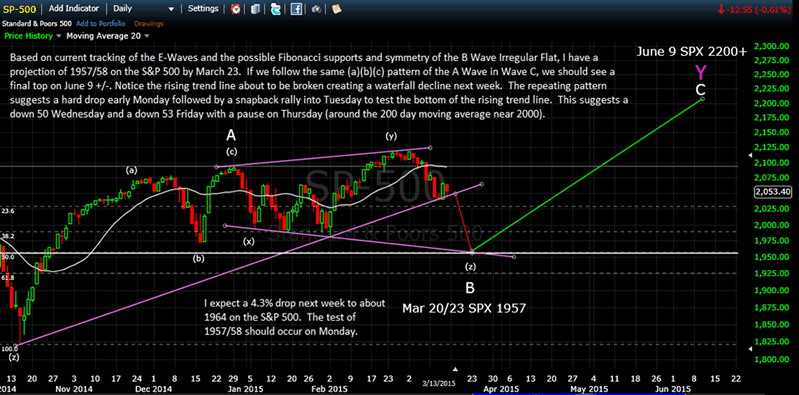Why The Stock Market Must Drop Next Week!
Stock-Markets / Stock Markets 2015 Mar 15, 2015 - 11:34 AM GMTBy: Brad_Gudgeon

 In the previous two articles, I explained that I have been looking for a pull back in the markets. Now with new data, I can boldly say when I believe the bottom will occur and the best odds of a price target on the S&P 500. The answers lie in the chart below. Using Elliott Wave and Fibonacci, I have determined a price of S&P 500 1957/58 and a date of March 20-23. I can also say with near exactness that we should fall nearly 4.3% on the week.
In the previous two articles, I explained that I have been looking for a pull back in the markets. Now with new data, I can boldly say when I believe the bottom will occur and the best odds of a price target on the S&P 500. The answers lie in the chart below. Using Elliott Wave and Fibonacci, I have determined a price of S&P 500 1957/58 and a date of March 20-23. I can also say with near exactness that we should fall nearly 4.3% on the week.
What is interesting about the waves is the pattern 3, 5 and 8 Fibonacci trading day moves. From the bottom on February 2nd to the next bottom on February 9th was 5 trading days. From February 9th to the next bottom on February 20th was 8 trading days, making a Fibonacci 13. From the bottom on February 20th to the top on February 24th was 3 trading days. It took another 3 trading days to make the next top on Mar 1st (this was THE top for Dow Industrials and NASDAQ). From the 8 trading day low on February 20 to the next 8 trading day low was March 3rd. The next day (March 4th) made a top, 3 days after the March 1 top. The March 11th low was 13 trading days from the February 20th low, which was 13 trading days from the February 2nd low.
The point of all this is counting back to the most dominant top on March 1 and adding 8 trading days we come to the March 12th top, which was also 5 trading days from the March 4th top. Friday’s action mimicked the action 8 trading days previous to, but added this curious twist: it increased its point price by 36.2% over the trading day 8 trading days previous! That comes out to 1.362, which is just shy of the Fibonacci 1.382 ratio. Even the Japanese Candlestick is identical Friday to the one 8 trading days previous.
We are at the point where the SPX is about break a rising wedge formation (see chart below). The normal expectation is a break of the rising trend line of that formation and then to snap back to that line (called snap back behavior). If we follow the sequence, Monday should be down hard from the get go, in fact it should gap down hard! It has a price projection of between SPX 2028-2031, from the current 2053.
The snap back should finish with a Tuesday close near 2050. Wednesday should see the SPX down about 50 points (this is quite strange, as FED day normally rallies into the FED announcement) to about SPX 2000, right at the 200 day moving average. A rally to near 2022 would be the expectation for Thursday, finishing at 2017. Friday (OPEX) should see the SPX drop (gapping down hard!) to 1964, or down 53. The following Monday should see the final test at 1957/58, the 50% retracement level of the A Wave (Oct 15 to Dec 29). It also fits the symmetry perfectly!

Brad Gudgeon
Editor of The BluStar Market Timer
The BluStar Market Timer was rated #1 in the world by Timer Trac in 2014, competing with over 1600 market timers. This occurred despite what the author considered a very difficult year for him. Brad Gudgeon, editor and author of the BluStar Market Timer, is a market veteran of over 30 years. The website is www.blustarmarkettimer.info To view the details more clearly, you may visit our free chart look at www.blustarcharts.weebly.com Copyright 2015. All Rights Reserved
Copyright 2015, BluStar Market Timer. All rights reserved.
Disclaimer: The above information is not intended as investment advice. Market timers can and do make mistakes. The above analysis is believed to be reliable, but we cannot be responsible for losses should they occur as a result of using this information. This article is intended for educational purposes only. Past performance is never a guarantee of future performance.
© 2005-2022 http://www.MarketOracle.co.uk - The Market Oracle is a FREE Daily Financial Markets Analysis & Forecasting online publication.


